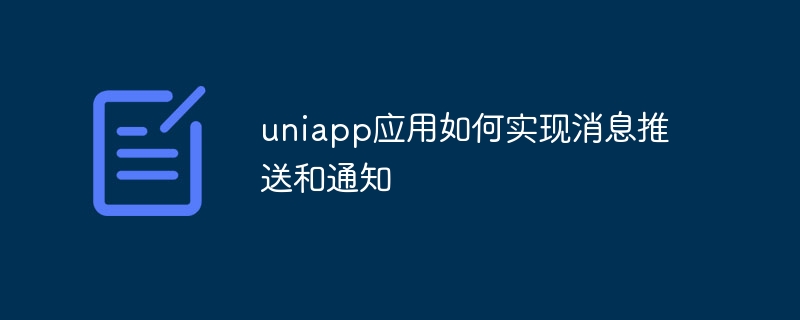Home >Web Front-end >uni-app >How to implement message push and notification in uniapp application
How to implement message push and notification in uniapp application
- WBOYWBOYWBOYWBOYWBOYWBOYWBOYWBOYWBOYWBOYWBOYWBOYWBOriginal
- 2023-10-18 09:19:412125browse

Uniapp is a cross-platform development framework based on Vue.js that can be used to develop applications that run on multiple platforms at the same time. When implementing message push and notification functions, Uniapp provides some corresponding plug-ins and APIs. The following will introduce how to use these plug-ins and APIs to implement message push and notification functions.
1. Message push
To implement the message push function, we can use the uni-push plug-in provided by Uniapp. This plug-in is based on Tencent Cloud Push Service and can push messages on multiple platforms. The following are the specific steps:
- Register an account on the Tencent Cloud Developer Platform and create an application.
- Install the uni-push plug-in in the Uniapp project. You can install it through the following command:
npm install @dcloudio/uni-push
- In
main.jsof the Uniapp project Introduce the uni-push plug-in and initialize it:
import UniPush from '@dcloudio/uni-push'
Vue.use(UniPush, {
// 在腾讯云开发者平台上创建应用时生成的 Secret ID
secretid: 'your_sceretid',
// 在腾讯云开发者平台上创建应用时生成的 Secret Key
secretkey: 'your_secretkey',
// 在腾讯云开发者平台上创建应用时生成的 SDK App ID
appid: 'your_appid',
// 推送通知的图标路径(可选)
icon: '/static/logo.png',
// 推送通知的声音路径(可选)
sound: '/static/sound.mp3',
// 推送通知点击后要打开的页面路径(可选)
page: '/pages/index'
})- Where push messages are required, call the
UniPush.pushMessagemethod to send push messages:
UniPush.pushMessage({
title: '消息标题',
content: '消息内容',
tokens: ['token1', 'token2'], // 推送目标设备的token列表,可以是一个或多个token
// 其他可选参数,如自定义字段等
})- When the device receives a push message, you can listen to
getui inonLaunchoronShowinApp.vue. messageevent to handle push messages:
export default {
onLaunch(options) {
uni.$on('getui.message', message => {
// 处理推送消息
})
},
onShow(options) {
uni.$on('getui.message', message => {
// 处理推送消息
})
}
} 2. Notification
To implement the notification function, we can use the uni-notify plug-in provided by Uniapp. This plug-in is based on the Notification API of HTML5 browsers and can display notifications in the browser. The following are the specific steps:
- Where notifications need to be displayed, call the
uni.$notifymethod to display the notification. You can call it in a method in the component, or in Vue Called in the event callback function in the instance:
uni.$notify({
title: '通知标题',
image: '/static/icon.png',
content: '通知内容',
onClick() {
// 点击通知的回调函数
},
onClose() {
// 关闭通知的回调函数
}
})- In the browser, when the user requests notification permission for the first time, the user needs to be asked whether to allow notifications. We can request notification permissions during the
createdlife cycle of the Vue instance:
export default {
created() {
if (Notification.permission === 'default') {
Notification.requestPermission()
}
}
}In this way, the user will be asked whether to allow notifications when opening the application.
The above are the specific steps to use Uniapp to implement message push and notification. By using the uni-push plug-in and uni-notify plug-in, we can easily implement these two functions. Of course, in actual development, it can also be customized and expanded according to specific needs. Hope this article is helpful to you.
The above is the detailed content of How to implement message push and notification in uniapp application. For more information, please follow other related articles on the PHP Chinese website!
Related articles
See more- How to disable automatic update email notifications in WordPress
- How to cancel page scroll bar in uniapp
- How to implement the WeChat login function of Android app on uniapp (operation process summary)
- How to implement the WeChat login function of the mini program on uniapp (process summary)
- How to jump to the page in uniapp? Two ways to introduce

